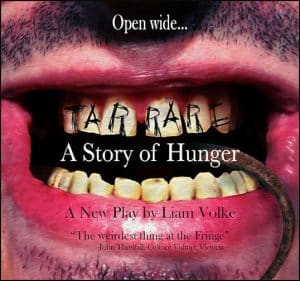The Mystery of Tarrare | Childhood Obesity News

Tarrare was a real historical character who looked like an addict and behaved like an addict — but probably was not. Born in the late 1700s, he soon showed an insatiable appetite, and his parents gave up and turned him loose. One source says he could eat 20 pounds of matter per day, even if part of it was dirt and stones. He stole garbage, and scraps from businesses that converted hides to leather, and reportedly ate cats and dogs alive. He would eat literally anything.
As a teenager, he allegedly could consume his own body weight (or half a cow) within a day. For a period of time, the youth was able to make that voraciousness pay for itself, by working as a busker or street performer. It was obvious to the audience that he “found a twisted sort of joy in shocking those around him with his bizarre behavior.” On the pragmatic side, the performance distracted the onlookers’ attention while Tarrare’s friends picked their pockets.
Naturally, the alarming omnivore became infamous. The public scorn that obesity sometimes meets today is typified by the people of the 18th century, who characterized him as “a true manifestation of one of the seven mortal sins known as Gluttony,” an attitude that continues into the present. But here is a twist: Apparently, in spite of all this, Tarrare never weighed more than 100 pounds.
Curiosity
Of course, medical experts tried to figure out what caused this strange fellow’s polyphagia, the medical term for extreme overeating. Experimenters brought him snakes, lizards, and all kinds of repulsive offal, which he dutifully devoured. Then, he was recruited into the military, and we are not even going to tell you what mission they assigned him. At any rate, the experiment failed, partly because of his fault and partly because it was a dumb idea. Also, he ate enough of the army rations to keep several soldiers well-fed, so it was a bad deal all around.
The next stop was a hospital where the experts experimented on Tarrare with uppers, downers, and every other sort of drug, which only increased his appetite. We won’t even go into that. Then a local baby went missing, and although nothing was proven, the researchers kicked him out. For several years his status was “whereabouts unknown,” before he wound up in a hospital to die of tuberculosis at age 26.
So?
What caused this unfortunate freak to eat so much? Contemporary medics were stumped, and modern academics do not have access to the victim’s lab samples, or any other solid evidence. Was it a tapeworm? Prader-Willi syndrome? Pica? Extreme iron deficiency, which makes the victim actually crave iron in the diet, even if it means eating horseshoes? A damaged amygdala, which can cause a number of disorders?
Dr. Don Moore hypothesizes that Tarrare suffered from…
[…] hyperactivity of hormones and dysfunction of components of the brain. His sensor that would let him know he was full was damaged. If he underwent a brain study, he would have probably been identified as having had an enlarged hypothalamus… He most likely had a parasite as well… a hookworm or roundworm, perhaps.
Despite the behavior, which fulfilled such criteria as destroying health and relationships and causing life to become unmanageable, it does not seem like addiction as we now understand it. Modern opinion is on the side of polyphagia, an outcome resulting from hyperthyroidism, which was unknown to the medical science of the victim’s time. (This could cause speculation about whether any of what we now call addiction could result from as-yet-unsuspected physical causes.)
A relatively undisturbing version of Tarrare’s biography is conveyed in a 3:44 animation titled “The tragic fate of the man who couldn’t stop eating.”
Your responses and feedback are welcome!
Source: “The Strange Life of Tarrare, the Insatiable Glutton,” HistoryDefined.net, 01/30/23
Source: “The Medical Mystery of Tarrare, a Cannibalistic French Spy,” Ripleys.com, 05/20/19
Source: “The tragic fate of the man who couldn’t stop eating,” BBC.com, undated
Image by STAF/CC BY 2.0 DEED








